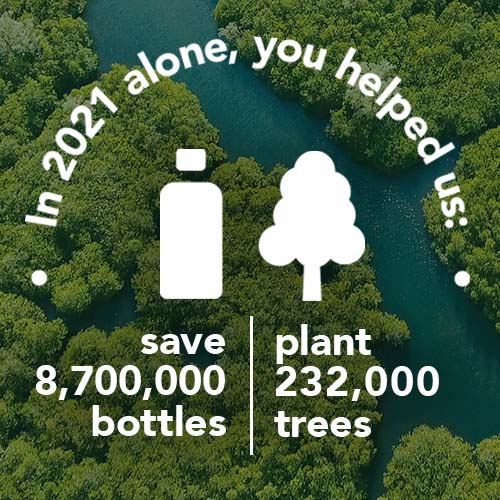I am absolutely stoked, because we have managed to reduce our carbon emissions from over 7,000 ton in 2018, to just over 2,000 ton in 2020. That’s a decrease of over 60% - over a period in which we grew in excess of 100% each year. So, despite that growth, the carbon footprint per bar is much smaller than it was.
But what is a Carbon Footprint? I’m sure most of us are familiar with it, through the masterful marketing campaign by BP, but do you actually know what it means? A product carbon footprint is the nice, consumer friendly term for the carbon emissions it took to produce materials, create a product and ship it from where it’s made, to wherever it’s used. 
A personal carbon footprint is the carbon emissions related to your day-to-day activities; your diet, transport, shopping habits and so on. There are many calculators out there that can give you an idea of what yours is, if you like.
Now, the term carbon footprint is a little misleading, as there is more than just one greenhouse gas.
Nitrous oxide, methane and others all help our atmosphere lock in that heat too. Nitrous oxide often comes from transport, whereas methane is produced by things breaking down in an environment where oxygen is the limiting factor (so landfills and such). A good carbon footprint analysis will take all of these into consideration.
As a business, we believe we are responsible for giving back more than what we take – that is what being a regenerative organisation is all about, after all.
And in regards to our carbon footprint, that means minimising our emissions as much as possible, and then offsetting what we cannot through robust offsets (not just the cheapest ones we can find).
We have our emissions measured by an independent agency each year – EKOS – and recently got our report back for 2020. This report covers everything from getting our materials to us, making the product, running our offices, and factory, then shipping the product out to you. I knew we would have made a dent, but not quite the dent we have! So I am absolutely stoked by the efforts from the whole team and our extended partners which has made a real impact.
There are three categories of carbon emissions, classified as scope one, two and three. Scope one is direct emissions from company owned (or controlled) facilities – like our office. Scope two is emissions from indirect sources, like the electricity generation for powering facilities and scope three is all the other indirect emissions (like freighting a parcel to an e-commerce customer). Scope three is infinitely harder to measure yet often a big chunk of a company’s emissions. It is often left out of carbon calculations because it is so tricky to measure. Our reporting includes scope one, two and three.
As a global company, there are no prizes for guessing where the majority of our carbon emissions stem from. Freight, freight, freight. Over 85% of our emissions come from freighting our product out and this is where we also saw the biggest decline from 2018 to 2020.
The biggest things we did were obvious; we opened warehouses in the USA and UK to bulk sea freight product to and act as our logistics hub. Air freight has as much as 47x more greenhouse gas emissions (GHG) than sea freight, so this is where the biggest drop came from. Obvious right? Yet why didn’t we do it earlier? This comes down to scale. We simply didn’t have the money to do this sooner, because our markets weren’t large enough in these regions. Now however, that’s a different story.
Under 1% of our GHG emissions comes from company waste. I’m proud of that one – we’re not waste free (no company is), but I’m proud of it being such a small amount of our total emissions.
Another drop in 2020 was business travel, and of course this was a given being as 2020 was the year COVID stopped everything and Aotearoa’s borders were closed. It is no secret that as a team, we travel a fair bit. We have always managed distributors, retailers and partners from our Head Office in NZ. The pandemic prevented this, so last year (2021), we opened offices in the USA and UK and built regional teams to do this for us. This not only enabled us to offer better customer service to our international partners, but also lessens the travel. To be transparent though, now we can, various team members will be travelling again for training, to new markets, and to do marketing and PR. But as always, we double offset all travel, and make it as efficient as possible. Here’s hoping Air NZ lives up to their promise of carbon neutrality by 2050.
So, I am pleased with this result. Not only does our product have just a fraction of the GHG emissions and other resources associated with equivalent products, but our operations are lessening their impact too.
So, what is next?
Manufacturing closer to market is a big one. It doesn’t make sense to ship everything to Aotearoa, make it here, then ship it out to other markets. Whilst we will always manufacture in NZ, for the NZ and close by markets, we are also looking at manufacturing in the Northern Hemisphere. This won’t mean we lose any team members here, nor change any of our rigorous ingredient or sourcing standards, but it will mean less transport kilometres (or miles).
And then there is ongoing work in our supply chain, our choice of ingredients we use, packaging, our suppliers for things like electricity, and whether in some facilities this can be self-generated.
We also offset our team’s personal lives through our partnership with Ecologi, who not only plant trees in our Ethique Forest (metaphorical – the trees are planted around the world), but invest in green tech and other offset initiatives, like renewable energy generation.
All in all, I am really pleased with where we have landed here, and it will be interesting to see what happens for 2021 (under measurement as we speak). In the meantime, we’ve got plenty of work to do to try and minimise these emissions even further! It’s impossible not to create carbon emissions in the world we live and work in now, but we can be mindful of them, and offset what we cannot prevent.



